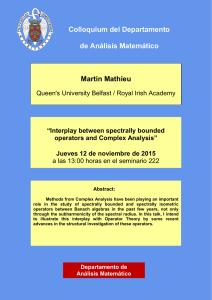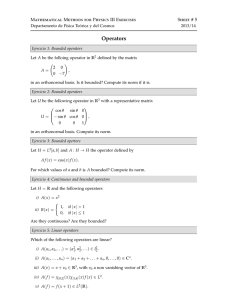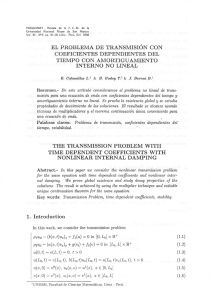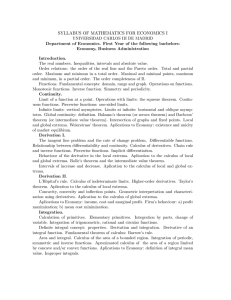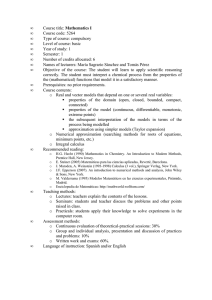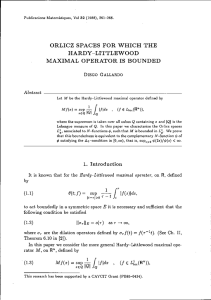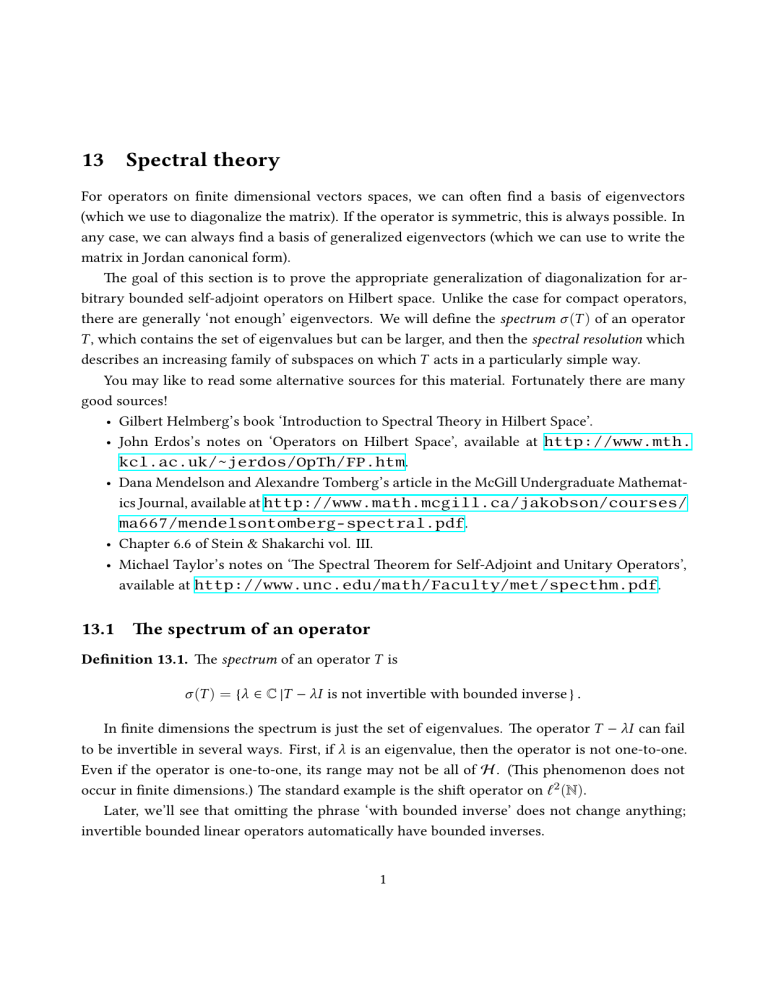
13 Spectral theory
For operators on finite dimensional vectors spaces, we can often find a basis of eigenvectors
(which we use to diagonalize the matrix). If the operator is symmetric, this is always possible. In
any case, we can always find a basis of generalized eigenvectors (which we can use to write the
matrix in Jordan canonical form).
The goal of this section is to prove the appropriate generalization of diagonalization for arbitrary bounded self-adjoint operators on Hilbert space. Unlike the case for compact operators,
there are generally ‘not enough’ eigenvectors. We will define the spectrum σ (T ) of an operator
T , which contains the set of eigenvalues but can be larger, and then the spectral resolution which
describes an increasing family of subspaces on which T acts in a particularly simple way.
You may like to read some alternative sources for this material. Fortunately there are many
good sources!
• Gilbert Helmberg’s book ‘Introduction to Spectral Theory in Hilbert Space’.
• John Erdos’s notes on ‘Operators on Hilbert Space’, available at http://www.mth.
kcl.ac.uk/~jerdos/OpTh/FP.htm.
• Dana Mendelson and Alexandre Tomberg’s article in the McGill Undergraduate Mathematics Journal, available at http://www.math.mcgill.ca/jakobson/courses/
ma667/mendelsontomberg-spectral.pdf.
• Chapter 6.6 of Stein & Shakarchi vol. III.
• Michael Taylor’s notes on ‘The Spectral Theorem for Self-Adjoint and Unitary Operators’,
available at http://www.unc.edu/math/Faculty/met/specthm.pdf.
13.1 The spectrum of an operator
Definition 13.1. The spectrum of an operator T is
σ (T ) = {λ ∈ C |T − λI is not invertible with bounded inverse } .
In finite dimensions the spectrum is just the set of eigenvalues. The operator T − λI can fail
to be invertible in several ways. First, if λ is an eigenvalue, then the operator is not one-to-one.
Even if the operator is one-to-one, its range may not be all of H . (This phenomenon does not
occur in finite dimensions.) The standard example is the shift operator on ℓ 2 (N).
Later, we’ll see that omitting the phrase ‘with bounded inverse’ does not change anything;
invertible bounded linear operators automatically have bounded inverses.
1
The complement of the spectrum is often referred to as the ‘resolvent set’, and the operator
(T − λI )−1 the ‘resolvent at λ’.
∑∞
Lemma 13.2. If ∥A∥ < 1 then I − A is invertible with bounded inverse k=0
Ak .
Proof: One easily checks that the given series converges to some bounded operator. Now
I − (I − A)
with norm converging to 0. Thus (I − A)
∑∞
n
∑
k=0
k
k=0 A
Ak = An+1
∑∞
= I , and similarly ( k=0
Ak )(I − A) = I .
□
Lemma 13.3. If A is invertible and ∥A − B∥ < ∥A−1 ∥ −1 then B is also invertible.
Proof: Apply Lemma 13.2 to A−1 B = I −(I −A−1 B).
□
Lemma 13.4. The spectrum of an operator T is a closed subset of C.
Proof: Take λ in the resolvent set of T , and µ within ∥(T − λI )−1 ∥ −1 of λ. Then apply Lemma 13.3
with A = T − λI and B = T − µI , so see that T − µI is also invertible so µ is in the resolvent set of
T.
□
Lemma 13.5. If ∥Af ∥, ∥A∗ f ∥ ≥ c ∥ f ∥ for some constant c, then A has a bounded inverse.
Proof: The inequality shows that A and A∗ are injective. Moreover, A has closed range, since if
fn = Aдn converge to some f , by the estimate the дn converge to some д and then f = Aд. The
range must be all of H : if z ⊥ range A then
0 = ⟨z, Aw⟩ = ⟨A∗z, w⟩
for all w, and since A∗ is injective, z = 0. Thus the operator A has an inverse, and that inverse is
bounded, by the inequality.
□
Lemma 13.6. The spectrum of a self-adjoint linear operator T is contained in the real line.
Proof: We want to construct a bounded inverse for T − (x + iy)I for any x ∈ R, 0 , y ∈ R. It
suffices to do this for T − iI . We calculate
∥(T − iI )f ∥ 2 = ⟨(T − iI )f , (T − iI )f ⟩
= ∥T f ∥ 2 + ⟨T f , −iI f ⟩ + ⟨−iI f ,T f ⟩ + ∥ f ∥ 2
≥ ∥ f ∥2.
The same argument applies to (T − iI )∗ = T + iI , and so by Lemma 13.5 T − iI has a bounded
inverse.
□
2
(A similar argument shows that the spectrum of a unitary operator is contained in the unit
circle in the complex plane.)
Lemma 13.7. The spectrum of a bounded linear operator T is compact, and in particular bounded
by its norm:
σ (T ) ⊂ B ∥T ∥ (0).
Proof: Suppose |λ| > ∥T ∥. Then I − λ−1T is invertible with a bounded inverse by Lemma 13.2,
and hence T − λI also has a bounded inverse so λ is in the resolvent set. This shows that the
spectrum is a bounded set, and combined with Lemma 13.4 and the Heine-Borel theorem, we see
that the spectrum is compact.
□
Theorem 13.8. The norm of a bounded self-adjoint linear operator T is the largest absolute value
of a point in the spectrum:
∥T ∥ = max |λ|.
λ∈σ (T )
Proof: Define
α = inf ⟨T f , f ⟩
β = sup ⟨T f , f ⟩.
∥ f ∥=1
∥ f ∥=1
Observe that ∥T ∥ = max{|α |, |β |}, and since β ≥ α, in fact
∥T ∥ = max{−α, β }.
We’ll first show that σ (T ) ⊂ [α, β], and then that α, β ∈ σ (T ).
If λ < [α, β], then another application of Lemma 13.5 shows that T − λI has bounded inverse,
so λ < σ (T ). In order to apply that Lemma, we need to show T − λI (which is self-adjoint) is
bounded below. Pick a unit vector f , and compute:
∥(T − λI )f ∥ 2 = ∥(T − ⟨T f , f ⟩)f + (⟨T f , f ⟩ − λI )f ∥ 2
= ∥(T − ⟨T f , f ⟩)f ∥ 2 + |⟨T f , f ⟩ − λ| 2
since the cross terms vanish, because ⟨(T − ⟨T f , f ⟩)f , f ⟩ = 0, and then
≥ |⟨T f , f ⟩ − λ| 2
≥ dist(λ, [α, β])2 .
We next want to show that α, β ∈ σ (T ).
3
Suppose first that ∥T ∥ = β. (The other case is similar, and we omit it.) We choose unit vectors
n→∞
fn so ⟨T fn , fn ⟩ −−−−→ β. In fact, we then have
∥(T − βI )fn ∥ 2 ≤ ∥T ∥ 2 − 2β⟨T fn , fn ⟩ + β 2
= 2∥T ∥(∥T ∥ − ⟨T fn , fn ⟩)
n→∞
−−−−→ 0.
Observe this makes it impossible for T − βI to have a bounded inverse, as if it did we could
compute
1 = ∥ fn ∥ 2
= ∥(T − βI )−1 (T − βI )fn ∥ 2
≤ ∥(T − βI )−1 ∥ 2 ∥(T − βI )fn ∥ 2
n→∞
−−−−→ 0.
Thus β ∈ σ (T ).
Next consider the operator S = βI − T , which has
αS = inf ⟨(βI − T )f , f ⟩ = 0
∥ f ∥=1
βS = sup ⟨(βI − T )f , f ⟩ = β − α
∥ f ∥=1
and ∥S ∥ = β − α. Repeating the exact same argument as above, we see that β − α ∈ σ (S), which
is equivalent to α ∈ σ (T ), because both say that T − αI does not have a bounded inverse.
□
Theorem 13.8 does not hold for non self-adjoint operators; the general statement for bounded
linear operators is that the ‘spectral radius’ is equal to limn→∞ ∥T n ∥ 1/n . Consider the example in
√
1 1+
finite dimensions T = *
where ∥T n ∥ = n 2 + 1.
,0 1 Theorem 13.9 (Spectral mapping theorem). Let p be a polynomial. Then
σ (p(T )) = p(σ (T )).
4
Proof: If p is constant, the result is trivial. Otherwise, take λ ∈ σ (T ), and observe that λ is a root
of the polynomial p(x) − p(λ), so we have
p(x) − p(λ) = (x − λ)q(x)
for some polynomial q, and hence
p(T ) − p(λ)I = (T − λI )q(T )
= q(T )(T − λI ).
Then p(λ) can not be in the resolvent set of p(T ), for then q(T )(p(T )−p(λ)I ) would give a bounded
inverse for T − λI . Thus p(λ) ∈ σ (p(T )).
∏
Conversely, suppose µ ∈ σ (p(T )). Factor p(x) − µ = c i (x − xi ) into a product of linear
∏
factors, so we also have p(T ) − µI = c i (T − xi I ). If every xi is in the resolvent set of T , this
expression would be invertible, giving a contradition. Thus some xi ∈ σ (T ), and then p(xi )−µ = 0,
giving the result.
□
Theorem 13.10. Suppose T is a bounded self-adjoint linear operator and p is a polynomial. Then
∥p(T )∥ = max |p(t)|.
t ∈σ (T )
Proof: First suppose p is a real polynomial. We use Theorem 13.8 to see ∥p(T )∥ = maxλ∈σ (p(T )) |λ|
and then the spectral mapping theorem (Theorem 13.9) to obtain the conclusion.
For the general case, note that ∥A∥ 2 = ∥A∗A∥ for all bounded operators A, and then ∥p(t)∥ 2 =
∥p(T )∗p(T )∥ = ∥(pp)(T )∥, at which point we can use the result for the real polynomial pp.
□
13.2 Positive operators
We’ll now introduce another class of linear operators, the positive operators.
Definition 13.11. A linear operator T is positive if (T f , f ) ≥ 0 for all f .
Lemma 13.12. A positive operator is necessarily self-adjoint.
Sketch: Use the polarization identity
1∑ k
⟨T f , д⟩ =
i ⟨T (f + i k д), f + i k д⟩
4 k=0
3
on both ⟨T f , д⟩ and ⟨f ,Tд⟩ = ⟨T f , д⟩ and compare real and imaginary parts.
5
□
In some sense all self-adjoint operators are ‘not far from being positive’, in the sense that
T + ∥T ∥I is positive.
Positivity defines an order relation on self-adjoint operators; we say A ≥ B if A − B ≥ 0.
One may readily check that this satisfies all the ‘obvious’ properties (throughout A and B are
self-adjoint):
• A ≥ B and B ≥ C implies A ≥ C,
• if α is a positive real number and A ≥ B, then αA ≥ αB.
• if α is a real number with α ≥ 1, and A ≥ 0, then αA ≥ A,
• if A ≥ B, then −B ≥ −A.
It’s not a total order, however. There positive operators A and B such that neither A ≥ B nor
B ≥ A. (Consider A = ( 10 00 ) and B = ( 00 01 ) .)
Lemma 13.13. If A is a bounded positive operator,
|⟨Af , д⟩| 2 ≤ ⟨Af , f ⟩⟨Aд, д⟩.
Proof: Any positive operator A lets us define a new sesquilinear form (f , д) = ⟨Af , д⟩ which
only fails to be an inner product because (f , f ) may be 0 without f being 0. Applying the proof
of the Cauchy-Schwarz inequality to this, we obtain the result.
□
One can think of this result as a family of generalizations of the Cauchy-Schwarz inequality.
Lemma 13.14. If A is a bounded positive operator, ∥Af ∥ 2 ≤ ∥A∥⟨Af , f ⟩.
Proof: Apply Lemma 13.13 with д = Af :
∥Af ∥ 4 = ⟨Af , Af ⟩2
≤ ⟨Af , f ⟩⟨A2 f , Af ⟩
≤ ⟨Af , f ⟩∥A2 f ∥∥Af ∥
≤ ⟨Af , f ⟩∥A∥∥Af ∥ 2
□
and finally cancel.
Theorem 13.15. An increasing sequence of self-adjoint operators {An }n , each bounded by a fixed
bounded operator B (i.e B ≥ An ), converges strongly to some operator A, also bounded by B.
Proof: For any fixed vector f , we have
⟨An f , f ⟩ ≤ ⟨An+1 f , f ⟩ ≤ ⟨B f , f ⟩
6
and hence limn,m→∞ ⟨(An − Am )f , f ⟩ = 0. By Lemma 13.14, we have
∥(An − Am )f ∥ 2 ≤ ∥An − Am ∥⟨(An − Am )f , f ⟩
and for m ≥ n ≥ 1
≤ ∥B − A1 ∥⟨(An − Am )f , f ⟩
so limn,m→∞ ∥(An − Am )f ∥ 2 = 0, i.e {An f }n is a Cauchy sequence. If we call its limit Af , it is easy
to verify that this defines an operator A, which is bounded by B.
□
Lemma 13.16. A decreasing sequence of positive operators {An }n converges strongly.
Proof: Apply Theorem 13.15 to {−An }n , which is bounded by 0.
□
13.3 Continuous functional calculus
Consider the ∗-algebra of bounded functions from σ (T ) to C. (The ∗-operation is complex conjugation.) We consider this algebra with the supremum norm. We’ll be thinking about various
sub-∗-algebras A, for example the polynomial functions on σ (T ) or the continuous functions on
σ (T ).
Definition 13.17. A functional calculus for an operatorT : H → H is a continuous ∗-homomorphism
from some ∗-algebra A of functions σ (T ) → C to B(H ), sending the constant function 1 to the
identity operator and sending the identity function x 7→ x to T .
Recall here a homomorphism is a linear map which preserves multiplication, and a ∗-homomorphism
π additionally satisfies π (f ) = π (f )∗ . Saying that the homomorphism is continuous means that
if fn → f in the supremum norm, then fn (T ) → f (T ) in the norm topology on B(H ).
Lemma 13.18. In a functional calculus for T , if f is real-valued then f (T ) is self-adjoint.
Proof: Use the assumption that the functional calculus is a ∗-homomorphism.
□
We say that an algebra A of functions X → C ‘has square roots’ if for each positive function
f ∈ A there is a positive д ∈ A so f = д2 . Observe that for X ⊂ C the algebra of polynomials
does not have square roots, but the algebra of continuous functions does.
7
Lemma 13.19. Suppose A is some sub-algebra of functions which has square roots. In any
functional calculus for T on A, if f ≥ 0 then f (T ) is a positive operator.
Proof: We write f = д2 for some positive function д. Since д is real-valued, д(T ) = д(T )∗ , and
so f (T ) = д(T )д(T )∗ is positive.
□
Theorem 13.20. A bounded self-adjoint operator T has a polynomial functional calculus.
∑
∑
Proof: Given a polynomial p(x) = ai x i , we define p(T ) = aiT i , and readily check that this
is a homomorphism. We need to assume T is self-adjoint to ensure this is a ∗-homomorphism. It
is continuous by Theorem 13.10, and the formula proved there:
∥p(T )∥ = max |p(t)|.
t ∈σ (T )
□
Theorem 13.21. A bounded self-adjoint operator T has a unique continuous functional calculus.
Proof: Since T is self-adjoint the spectrum σ (T ) is contained in R by Lemma 13.6. Moreover since
T is bounded the spectrum is contained in some closed interval. Thus every continuous function
f on σ (T ) is a uniform limit of polynomial functions fn , and the polynomial functional calculus
of Theorem 13.20 gives operators fn (T ). By Theorem 13.10 the sequence fn (T ) converges in norm,
and we must define f (T ) to be this limit.
An easy argument shows this definition is independent of our choice of approximating sequence.
To verify that this defines a ∗-homomorphism we carefully choose approximating sequences.
For example, if f is a uniform limit of polynomials fn and д is a uniform limit of polynomials дn ,
then f д is the uniform limit of the polynomials fnдn (here we use that the spectrum is compact),
and so (f д)(T ) = f (T )д(T ).
□
We’ll next build a bigger functional calculus, but one which is a little quirky: it’s not defined
on a subalgebra of C(σ (T )), but on a sub‘rig’.
Definition 13.22. Let P denote the set of positive functions on σ (T ) which are decreasing pointwise limits of continuous functions.
It’s clear that you can add and multiply such functions and remain in this class. However you
can only multiply by non-negative scalars: multiplying by a negative scalar the new function
would not be positive!
8
(In fact, we could characterize the functions in P as the non-negative upper semicontinuous
functions. A function is upper semicontinuous at x 0 if for every ϵ > 0 there exists a δ > 0 so for
x ∈ (x 0 − δ, x 0 + δ ), f (x) < f (x 0 ) + ϵ. We won’t pursue this here.)
When we say we have a functional calculus π defined on P we mean that the property of a
homomorphism π (α f ) = απ (f ) only has to hold for positive α. (Finally, since the functions in
P are all positive, saying π is a ∗-homomorphism merely means that π (f ) is self-adjoint for all
f ∈ P.)
Lemma 13.23. Suppose fn is a decreasing sequence of continuous functions on a compact set X ,
converging pointwise to some function f . Suppose д is some continuous function with f ≤ д,
and ϵ > 0. Then there is some n 0 so fn ≤ д + ϵ for all n ≥ n 0 .
Proof: Consider the functions дn = max{ fn , д}. These are continuous functions, converging
pointwise to the continuous function д. Since we are on a compact set, this convergence is in
fact uniform! The conclusion follows easily.
□
Theorem 13.24. A bounded self-adjoint operator T has a unique functional calculus on P, such
that if fn is a decreasing sequence of continuous functions converging to f , then fn (T ) converges
strongly to f (T ).
(Note that we still insist that this functional calculus is continuous, i.e. if { fn } ⊂ P converges
in the supremum norm to f ∈ P, the operators fn (T ) converge in norm to f (T ).)
Proof: If f ∈ P is the pointwise limit of continuous positive functions fn , with fn+1 ≤ fn , then
we define f (T ) to be the limit, provided by Lemma 13.16 of decreasing positive operators fn (T )
provided by the continuous functional calculus of Theorem 13.21.
We first check that this is well-defined, that is, independent of our choice of approximating
sequence. Let дn be another such decreasing sequence of positive continuous functions, converging pointwise to f . We use Lemma 13.23 to see that for each fixed k and ϵ > 0, there is an n 0 so
that for all n ≥ n 0 , fn (x) ≤ дk (x) + ϵ for every x ∈ σ (T ). Applying these functions to T , we have
fn (T ) ≤ дk (T ) + ϵ
and taking n to infinity
lim fn (T ) ≤ дk (T ) + ϵ
9
then k to infinity
lim fn (T ) ≤ lim дk (T ) + ϵ
and finally ϵ to zero gives
lim fn (T ) ≤ lim дk (T ).
However the reverse inequality holds equally well, so we see the limits must be the same.
Next we need to check this construction defines a ∗-homomorphism. This is quite easy; the
hardest part is to check multiplicativity. We pick approximating sequences fn for f and дn for д,
then use the approximating sequence fnдn for f д. We then need to see that
lim (fnдn )(T )x = lim fn (T )дn (T )x = f (T )д(T )x
n→∞
n→∞
for each vector x. This follows from
∥ fn (T )дn (T )x − f (T )д(T )x ∥
≤ ∥ fn (T )(дn (T ) − д(T ))x ∥ + ∥(fn (T ) − f (T ))д(T )x ∥
≤ ∥ f 1 (T )∥∥(дn (T ) − д(T ))x ∥ + ∥(fn (T ) − f (T ))д(T )x ∥.
Finally, we need to check that our construction is continuous. Suppose f ≤ д. Choose approximating sequences fn for f and дm for д. Again applying Lemma 13.23, for each m there is
number n 0 (m) for so all n ≥ n 0 (m)
fn (x) ≤ дm (x) + m−1
and thus
f (T ) ≤ fn (T ) ≤ дm (T ) + m −1I .
Taking the pointwise limit, we see f (T ) ≤ д(T ). In fact, being order preserving in this way
ensures continuity. Suppose f and д in P are ϵ apart in the supremum norm, i.e. f (x) ≤ д(x) + ϵ
and д(x) ≤ f (x) + ϵ. Then we have f (T ) ≤ д(T ) + ϵI and д(T ) ≤ f (T ) + ϵI , from which it easy
follows that f (T ) and д(T ) are within ϵ in the operator norm.
□
13.4 Spectral resolution
Definition 13.25. A spectral resolution is a family {E(λ)}λ∈R of orthogonal projections, such that
10
• the projections are increasing, in the sense that E(λ) ≥ E(µ) if λ > µ,
• the family is right continuous, in the sense that for each f ,
lim E(λ)f = E(µ)f .
λ>µ
λ→µ
(This is convergence in the strong operator topology.)
Right continuity allows for the possibility that the projections E(λ) jump upwards in size as
λ approaches µ from below.
Theorem 13.26. For a bounded self-adjoint operator T , the operators E(λ) = χ (−∞,λ] (T ) provided
by the functional calculus of Theorem 13.24 form a spectral resolution.
Proof: Since the functions χ (−∞,λ] are real and satisfy f 2 = f , the operators χ (−∞,λ] (T ) are all
orthogonal projections.
If λ > µ, we have χ(−∞,λ] ≥ χ (−∞,µ] + χ [ µ+λ ,λ] , and so E(λ) ≥ E(µ) + χ[ µ+λ ,λ] (T ), and this
2
2
second term is itself an orthogonal projection, and hence positive. Thus E(λ) ≥ E(µ).
To see the family is right continuous, we use the additional continuity for pointwise decreasing limits guaranteed by our functional calculus for P. Each function χ (−∞,λ] can be realized as
the decreasing pointwise limit of continuous functions
1
λ
ϕn (x) =
1 − n(x − λ)
0
if x ≤ λ
if x ∈ [λ, λ + n−1 ]
if x ≥ λ + n−1 .
Observe that even though ϕnλ is not converging in the supremum norm to χ (−∞,λ] , if we fix an n
µ
then ϕnλ converges uniformly to ϕn as λ goes to µ.
Now take λ > µ, and observe
∥E(λ)f − E(µ)f ∥ = ∥E(λ)ϕnλ (T )f − E(λ)E(µ)f ∥
≤ ∥ϕnλ (T )f − E(µ)f ∥
µ
≤ ∥ϕnλ (T )f − ϕn (T )f ∥+
µ
+ ∥ϕn (T )f − E(µ)f ∥
and then taking n sufficiently large (depending on f )
µ
< ∥ϕnλ (T )f − ϕn (T )f ∥ + ϵ/2
11
and then taking λ sufficiently close to µ (depending on n)
< ϵ.
□
Theorem 13.27. For a bounded self-adjoint operator T and the spectral resolution E(λ) defined
in Theorem 13.26, we have
∫
T =
λdE(λ)
σ (T )
in the sense that for each x, y ∈ H
∫
⟨T x, y⟩ =
λd⟨E(λ)x, y⟩
σ (T )
where the right hand side is the Lebesgue-Stieltjes integral for the function ⟨E(λ)x, y⟩. In fact,
for any continuous function f on σ (T ) the operator f (T ) provided by the continuous functional
calculus of Theorem 13.21 is given by
∫
f (T ) =
f (λ)dE(λ)
σ (T )
A remark: when we previously talked about Lebesgue-Stieltjes integrals, we only worked
with non-decreasing functions. The function ⟨E(λ)x, y⟩ generally isn’t non-decreasing, but using
polarisation we can write it as a linear combination of four non-decreasing functions
1∑ k
⟨E(λ)x, y⟩ =
i ⟨E(λ)(x + i k y), (x + i k y)⟩
4 k=0
3
and this is enough.
Proof: Consider a sequence λ 0 ≤ λ 1 ≤ · · · ≤ λk such that σ (T ) ⊂ [λ 0 , λk ], and suppose λi+1 −λi <
∑
δ for all i. Now on σ (T ) we have x = x χ (−∞,λ0 ] + kj=1 x(χ(−∞,λ j ] − χ (−∞,λ j−1 ] ) and so
x ≤ λ 0 χ(−∞,λ0 ] +
k
∑
λ j (χ(−∞,λ j ] − χ (−∞,λ j−1 ] ) ≤ x + δ .
j=1
Applying these functions to T , using the functional calculus from Theorem 13.24, we obtain
T ≤ λ 0 E(λ 0 ) +
k
∑
λ j (E(λ j ) − E(λ j−1 )) ≤ T + δI .
j=1
12
Thus T is within δ of λ 0 E(λ 0 ) +
⟨T x, y⟩ is then within δ ∥x ∥∥y∥ of
∑k
j=1 λ j (E(λ j )
λ 0 ⟨E(λ 0 )x, y⟩ +
k
∑
− E(λ j−1 )) in the operator norm. The quantity
λ j ⟨(E(λ j ) − E(λ j−1 ))x, y⟩
j=1
which, as δ goes to zero, approaches the Lebesgue-Stieltjes integral
∫
λd⟨E(λ)x, y⟩.
σ (T )
To see the corresponding expression for an arbitrary continuous function f , we use uniform
continuity to show that for any ϵ > 0 we can find a δ > 0 so that λi+1 − λi < δ implies
f (x) − ϵ ≤ λ 0 χ (−∞,λ0 ] +
k
∑
λ j (χ (−∞,λ j ] − χ (−∞,λ j−1 ] )
j=1
≤ f (x) + ϵ.
□
After that the argument is the same.
Question: How does this compare with our analysis of the eigenvectors of compact operators?
13.5 Borel functional calculus
Now that we’ve obtained the spectral resolution, we can ‘finish off’ spectral theory for bounded
self-adjoint operators by defining a functional calculus for all Borel measurable functions on the
spectrum, subsuming each previous functional calculus.
Theorem 13.28. A bounded self-adjoint operator T has a functional calculus for bounded Borelmeasurable functions.
Proof: Define f (T ) for a Borel function f by
∫
f (T ) =
f (λ)dE(λ).
σ (T )
Showing that this is continuous is not hard. Suppose supx ∈σ (T ) | f (x)| < ϵ. Then we calculute
∫
|⟨f (T )x, y⟩| =
f (λ)d⟨E(λ)x, y⟩
σ (T )
13
∫
<ϵ
d⟨E(λ)x, y⟩
σ (T )
= ϵd⟨E(λ)x, y⟩(σ (T ))
= ϵ(⟨E(λ + )x, y⟩ − ⟨E(λ − )x, y⟩)
where λ ± are the least greatest and least points in σ (T )
= ϵ⟨x, y⟩
because E(λ + ) is the identity and E(λ − ) is zero. This shows f (T ) has norm at most ϵ.
With this in hand, showing that the Borel functional calculus is actually a ∗-homomorphism
is easy. We check it first for simple functions, and then use continuity to pass up the chain to
arbitrary bounded Borel-measurable functions.
□
Providing a uniqueness statement for the Borel functional calculus would take us too far afield.
Finally, I want to sketch a fancier proof of both the spectral resolution and the Borel functional
calculus. This entirely skips over our discussion of positive operators and the functional calculus
for upper semicontinuous functions. We just need the continuous functional calculus!
‘High-powered’ sketch of Theorems 13.27 and 13.28: We can think of the continuous functional
calculus as giving us a family of linear functionals on the space of continuous functions C(σ (T )).
For each x, y ∈ H , define µx,y (f ) = ⟨f (T )x, y⟩.
By another Riesz representation theorem which we will prove later when we study Banach
spaces, every linear functional on the space of continuous functions (on a compact metric space,
in particular σ (T ) is fine) is actually realized by a complex measure. That is, there is a Borel
measure νx,y so that
∫
⟨f (T )x, y⟩ =
f νx,y .
Next, we use this to build a functional calculus for arbitrary bounded Borel functions, by the
same formula. There is some work to show that this is in fact a functional calculus, i.e. linear,
multiplicative, and respecting the ∗-operation, but all are easily proved using the fact the arbitrary
bounded Borel functions are monotone pointwise limits of simple functions, and the dominated
convergence theorem.
Finally, we extract the spectral resolution as E(λ) = χ (−∞,λ] (T ) using the Borel functional calculus. By construction ⟨E(λ)f , д⟩ = ν f ,д ((−∞, λ]), and ν f ,д is thus the Lebesgue-Stieltjes measure
d⟨E(λ)f , д⟩.
□
14
13.6 Some applications
• Every positive operator has a positive square root.
• Polar decomposition: every bounded operator can be written as a positive operator times
an isometry. (More specifically, |T | = (T ∗T )1/2 is the unique positive operator satisfying
∥T x ∥ = ∥|T |x ∥, and there is a unique partial isometry U with ker U = kerT and U |T | = T .)
(Exercise: find the polar decomposition of the unilateral shift.)
• Every self-adjoint operator is unitarily equivalent to multiplication by some a ∈ L∞ (X ) on
a L2 (X ) for some σ -finite measure space X . (If the Hilbert space is non-separable you lose
σ -finiteness.) The spectrum is the essential range of a.
• Every bounded operator on a Hilbert spaces can be written as a linear combination of four
unitaries. (To start, write a self-adjoint operator as a linear combination of two unitaries,
√
√
using the identity x = 1/2((x + i 1 − x 2 ) + (x − i 1 − x 2 )) on [−1, 1].)
• For self-adjoint operators, the spectrum consists of generalized eigenvalues (i.e. if λ ∈ σ (T ),
then there is a sequence of unit vectors fn so ∥(T − λI )fn ∥ → 0).
• Unfortunately, all the interesting self-adjoint operators from quantum mechanics are unbounded!
15

